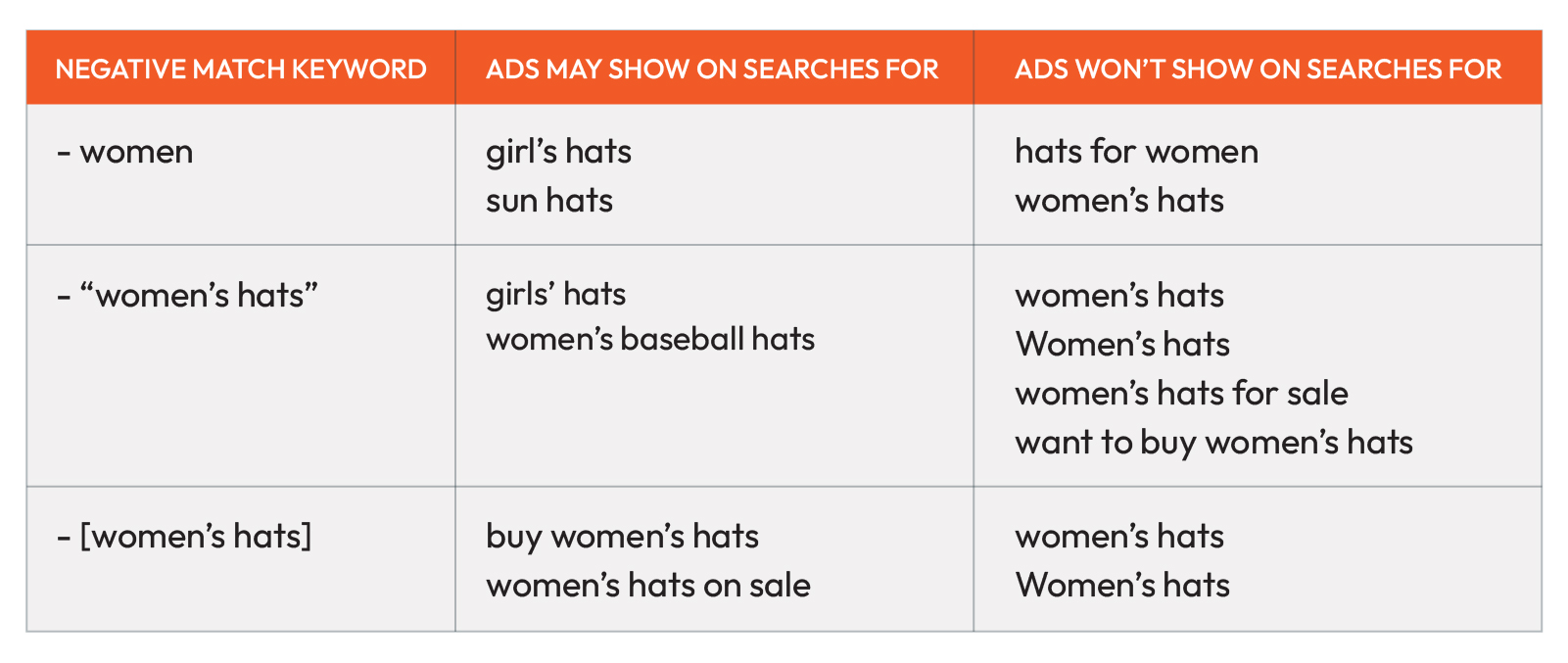There’s a lot of talk about bidding on the right pay-per-click (PPC) campaign keywords. But, just as important is identifying the search terms you don’t want to be associated with—words or phrases that trigger your ads in the wrong search scenario, attracting the wrong audience and incurring unnecessary cost. These are known as negative keywords.
Before we dig into the specific strategies, let’s get our heads around the different types of negative keywords you can influence.
Types of Negative Keywords
Negative Broad Match
Use this function to prevent your ad from showing any time the entire negative Broad term, regardless of the search term's order, is used within a search query. However, different from “positive” Broad Match keywords, this will not block variations (synonyms) or plurals of the word. Also, if your negative Broad Match contains multiple words, the search engine won’t block it if a searcher uses only one of the words in the phrase. For example, blocking “sunglasses” will not prevent ads shown when a user searches “glasses.”
Because negative Broad Match excludes a wide range of keywords, it should only be used when you want to exclude every term related to that word. For example, block “rental” when you do not offer rental services as a car dealer; block “career” when you do not intend to attract job applicants with your ads. When in doubt, use a stricter match type such as Phrase or Exact.
Negative Phrase Match
This will block ads being triggered by search terms including the Negative Phrase in the exact word order. This is particularly useful if you want to block some words related to the keywords on which you are bidding. For example, a car repair center may want to block “driver jobs” instead of just “jobs.” This action would block searches for “car driver jobs” or “truck driver jobs” but still allow relevant searches such as “repair job.”
I also find Negative Phrase to be useful in maintaining the right context. For example, if you are an IT company, you may want to consider blocking “company IT,” as people searching with that term could be looking for other services.
Negative Exact Match
This will prevent search queries from triggering ads exactly the same as the Negative Exact keywords do. This is very useful when you want to block exact terms within a category. For example, in your “blue pants” campaign, block “red pants,” “yellow pants,” etc. We also find it useful to add applicable negative keywords exactly as they appear in search query reports. This is because AdWords will only display negative keywords as “Added” in the search query interface when Exact Match is added. So, if we see “car driver jobs” appear in the search query report and we intended to add “jobs” as a negative keyword, we also always add “car driver jobs.” This will make it easier to get a sense of what has been added and eliminate duplicate work in the future.
Below is more-visual example of how each negative keyword type works. 
Now, it’s time to put in place a more-complete negative keyword strategy.
Successful negative keyword implementation saves time and money by avoiding unwanted traffic. It is also instrumental in funneling searchers to the most relevant content, providing a better user experience and positively influencing site convertibility.
How to Create an Effective Negative Keyword Strategy
1. Choose the match type that makes most sense
Thoroughly understand the function of each negative keyword match type and select the most effective one at blocking the search query (or similar terms) being evaluated. For example, for search query, “what is the best sleep medicine that will not advance dementia,” it is not a good idea to add “best sleep medicine” (as broad or phrase) if your business sells “sleep medicine board review courses.” Instead, add this term as exact and add a few versions of similar searches (from reviewing search terms) such as [best medicine for sleep] [best medicine to get sleep]. Master the functions of each match type and use the one that makes most sense.
2. Use negative keywords at the campaign and ad group levels
Use of both campaign and ad group level negative keywords is a critical part of negative keyword strategy. Take a home appliance store for example. For campaign “Washers,” we may want to block terms related to other rooms in the house (such as “sofas,” “chairs” and ”coffee tables”), other household appliances (such as “dishwashers” and “dryers”) as well as other broad terms that do not apply (ex. “free” and “used”). Within this campaign, you may have ad groups “Kenmore Washers,” “Samsung Washers.” In that case, it’s necessary to block “Kenmore” in the “Samsung Washers” ad group and vice versa. This strategy ensures funneling of search traffic to the most appropriate ad group with the most relevant ad copy.
Important Note: When duplicating ad groups, be aware that this includes duplicating ad group level keywords. It is always necessary to check negative keywords (and other ad group level settings) to ensure applicability.
3. Use a shared negative keyword list across campaigns
Applying keywords across campaigns is done most quickly by adding them to a shared keyword list. This list can include all campaigns or only a few campaigns closely related to each other (for example, a list shared across branded campaigns versus product campaigns). Developing a list of common negative keywords (ex. careers) for your clients can help save time and money when new clients come on board.
Pro tip: Sometimes you may also run into negative keywords that may not apply at the moment, but may become relevant in the future or vice versa (ex. seasonal offerings, products in development). In this case, having a negative keyword list dedicated to these terms can help you quickly target/avoid traffic coming from those keywords.
4. Keep a negative keywording schedule
Negative keywording should be performed regularly. Depending on the search volume, two to three times a month is a good starting point. To avoid duplicated efforts, we recommend keeping a negative keywording schedule. For example, if you decide to do negative keywording twice a month, on the 16th of June, review search terms for date range June 1 – June 15th, and on July 1st, review search terms for date range June 16 – June 30.
5. Review negative keywords quarterly
It is recommended that you review all your negative keywords twice a year to remove negative keywords added by accident or mistake. This is especially helpful when there are multiple account managers working on the account who may have different approaches to negative keywords.
Closing thoughts: We’ve noticed a general lack of negative keyword strategy across all industries and company sizes. So, if you are a client, ask your agency about their negative keyword strategy for your PPC account.
What are we doing for to separate traffic for our brand from our competitors’ brand terms? Are we using advanced techniques to help improve cost effectiveness? Keep your agency in check.


